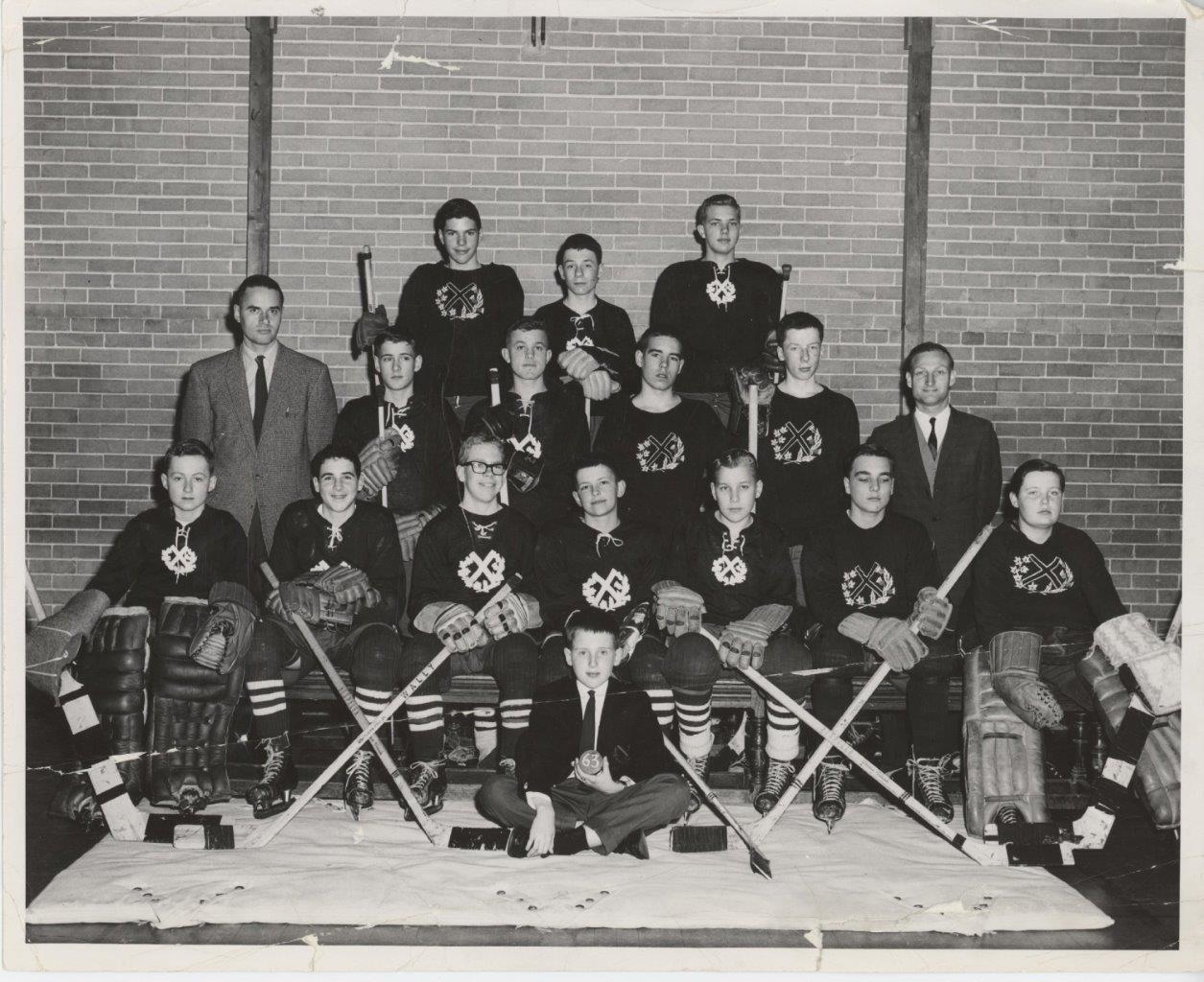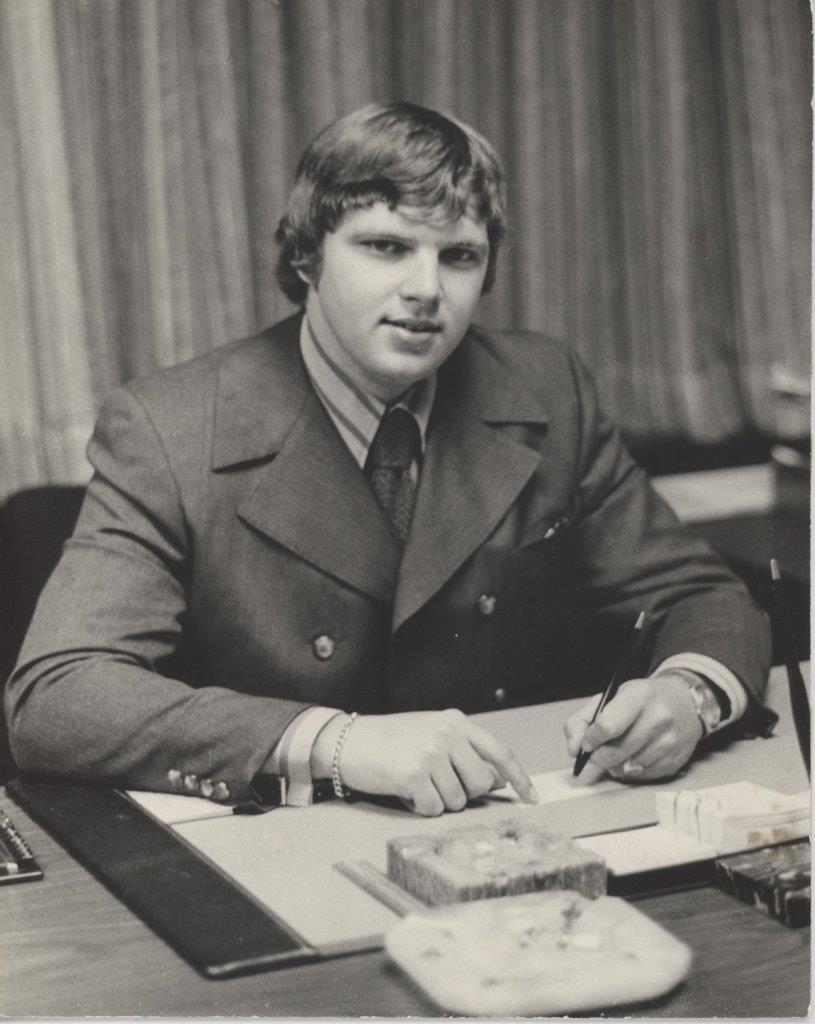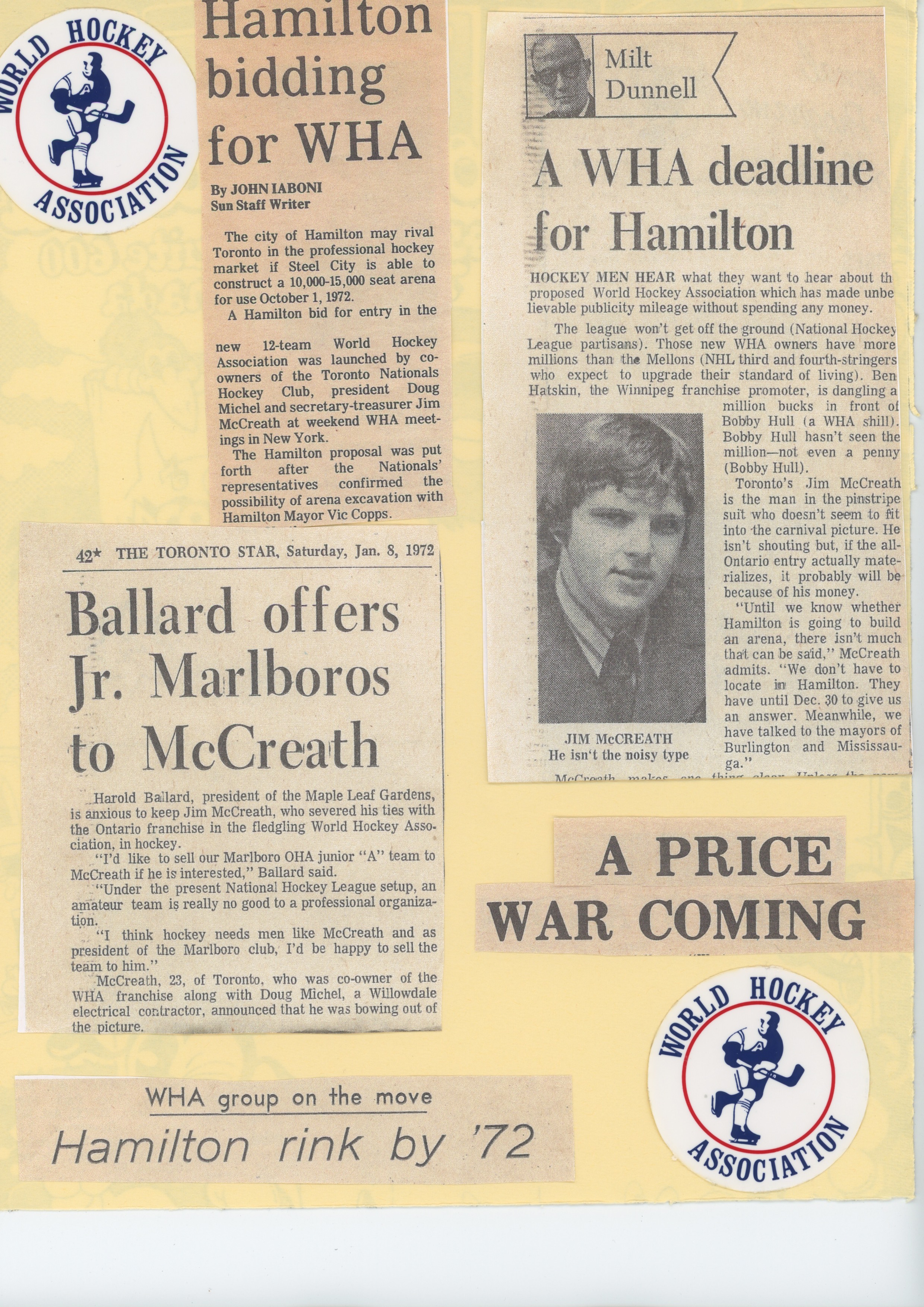A Rink Rat’s Tail.
‘The Great One’
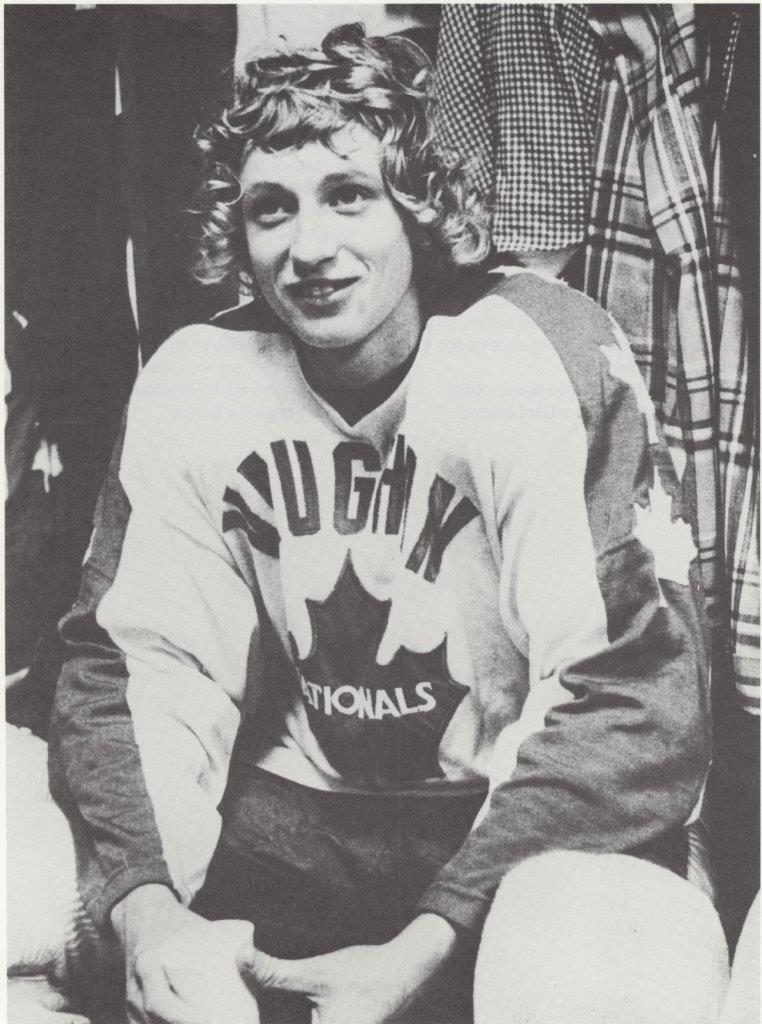
Wayne in the Vaughan Nationals dressing room 1974
Wayne Gretzky was arguably the greatest hockey player to ever lace on skates. I never met Wayne, but I was responsible for putting two small pieces of his hockey journey together that eventually lead to the National Hockey League.
In 1973 I owned and operated an amateur hockey organization, the Toronto Young Nationals.
There were ten teams involved ranging in age from 8-18, or in hockey language from minor atom to tier two junior ‘A.’
You had to really love hockey to get this crazy about a hobby that took so much blood, sweat and tears, but I did love hockey.
There was a ton of competition to get the elite players available, so you had to get close to the kid’s parents and persuade them that your team offered the best chance for future advancement.
Often the organizations with the best general mangers and scouts ended up with at the top of the standings. Coaches are certainly important, but they need the raw material to mould a championship team.
The Young Nats played most of their home games in and around Toronto, but our Jr. A team played out of an arena in a small town just north of Toronto named Vaughn. It was a band-box kind of facility, slapped together without many amenities, but when we filled it up to the rafters with the die hard Nats fanatics, the place had that special small rink rock ’em sock ’em buzz.
So we had the fans and the rinks, but what about the players? I was lucky enough to meet a very special hockey man, Sam McMaster. Sam was a high school business teacher by day, but a hockey scouting genius by night.
In later years he managed the Sudbury Wolves of the Ontario Major Junior circuit and was voted the league’s executive of the year in 1991. He went onto to the National Hockey League to manage the Los Angeles Kings, as well as holding many administrative and scouting positions.
For the Nats, he was like gold.
So now, back to Wayne.
The Nats had the Jr. A team in Vaughn and Sam McMaster in 1975. One thing they didn’t have was me.
I was given an offer I couldn’t refuse from an Italian gentleman and his partner, both of whom had sons that they wanted to play for the organization.
So it was ‘arrivederchi hockey, ciao, the rest of my life.’
Before I left though, Sam and I had extensive talks about how we could get Wayne to come to Toronto from the town he was raised in and play for the Nats.
Wayne’s hometown, Brantford, is about 100 miles from Toronto, and the rules of amateur hockey in Canada at the time stated that no player could play for a team that wasn’t in their home town until the age of sixteen. In 1975 Wayne was fourteen.
Long story short, Sam went to work on Wayne’s parents, Walter and Phylis, who in turn went to work to change the hockey law of the land, and…TA DA, before you could say “he shoots he scores,” Wayne was in a Vaughn National jersey!
So, I got the rink, I got the general manager, and that’s how Wayne left home to start his amazing career.
Applause please.
The Fancy Skater
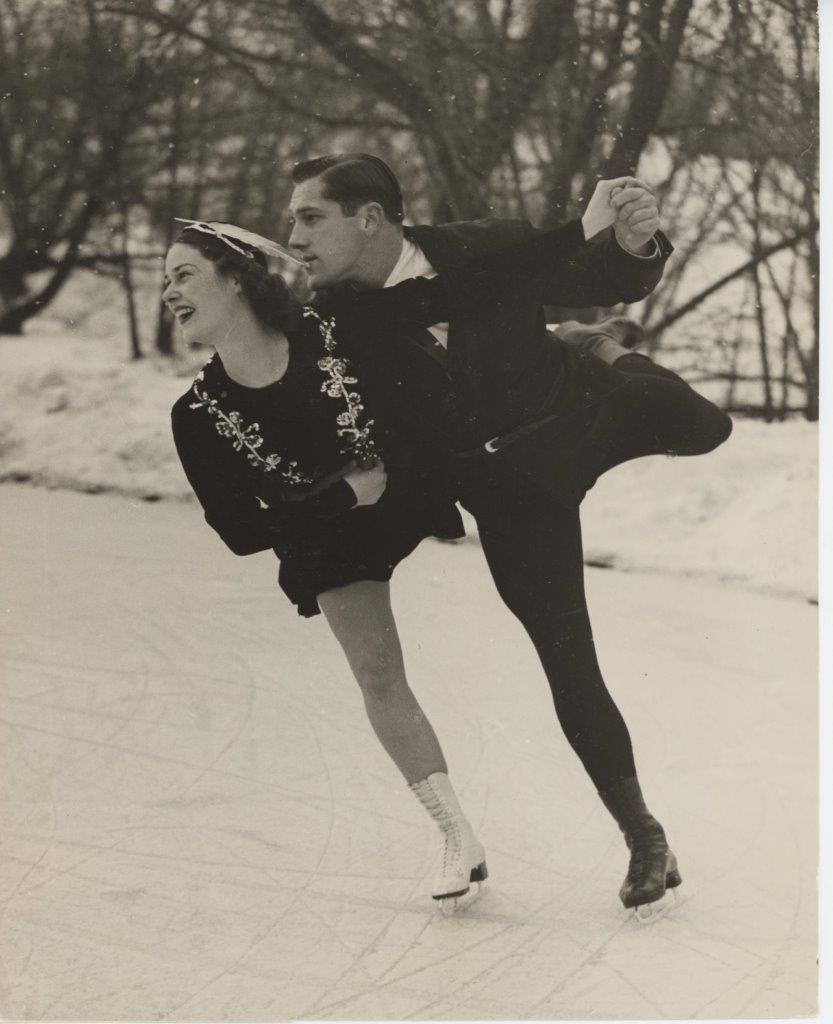
My father Ralph, two time North America pairs champion with partner Eleanor O’Meara.
Now let’s go back to the beginning of my love for hockey and find out how I managed to end up as a hockey executive. It was never my intension, it just sort of happened, but along the way I met some of hockey’s most influential characters…crazy ones too.
Growing up in Toronto in the early 1950’s, it was hard not to be a hockey fan. T.O. was a small town then, and the Maple Leafs were are only professional team that competed on the North American stage.
The Leafs were good then too. They had won six Stanley cups before I was born in 1948, then another in my birth year and six more up to 1967.
Constantine Falkland Cary Smythe, know as ‘Conn’ was the mastermind behind building what is now one of the richest sports franchise in the world.
Coming from humble beginnings, Smythe grew to be an elite athlete, decorated war hero, champion thoroughbred breeder, and hockey genius.
He built Maple Leaf Gardens at the height of the depression, in part giving his workmen shares of his company in lieu of wages.
But more than anything, he knew hockey players.
His son Stafford would follow in his father’s footsteps, winning six Stanley Cups of his own.
No other family, person or corporate entity has won a Stanley Cup for the Toronto Maple Leafs while they were in control of the team.
Little did I know as a young hockey fan that I would become intimately connected with the Smythe family many years later.
To understand my hockey roots, one must understand my dad.
My father Ralph was an accomplished athlete. In high school he excelled as a running back for his football team and goal scorer for the hockey team. His skating skills were so advanced that opposing players would slide on the ice in front of him to slow his rushes down.
One day his coach brought a wooden bench onto the rink and told him to jump over it. “This, he explained, was the only way to get around the sliders.”
So Ralph leapt and he leapt and soon he had given up hockey for figure skating.
It was a sport he excelled in, winning North American championships in men’s, pairs, twice, and something called ‘Fours’ where two couples would skate together, between 1934 and 1941.
He also won several Canadian dance, mens and pairs championships and was picked as a member of Canada’s 1940 Olympic figure skating team that never made it to the Olympics. The outbreak of World War II cancelled the Olympics and changed so many peoples lives.
My dad enlisted in the Canadian army and served five years in England, North Africa and France rising to the rank of major. Like so many men that were lucky enough to survive the horrors he must have experienced, he never talked about the war.
Upon his return to Toronto he attended law school then practiced his trade for nearly fifty years.
Ralph loved sports, particularly football and hockey, so he and my mum would take me to university and pro Canadian Football League games starting when I was very young. I loved the crowds and the colours of the uniforms, and the do or die atmosphere. I became a football fan for life.
Hockey was another story. Unless you knew someone it was very difficult to obtain Maple Leaf tickets. Maple Leaf Gardens had a capacity of just over fifteen thousand seats, and they were filled to the rafters for every game.
I don’t remember when my first visit to the Gardens was to see the Leafs play, but I do remember that my dad and I were in the stands the night the Leafs won their last Stanley Cup on May 2nd 1967, beating the Montreal Canadiens 3-1.
I was eighteen years old then, and in my wildest dreams never imagined that I would be a grandfather three times over and still waiting for the Stanley Cup to come back to Toronto.
My own hockey awakening took place in our backyard in west end Toronto during the early 1950’s.
I woke up one wintery morning and looking out my window, what should I see down below but a totally solid sheet of ice with a hockey net at one end. The neighbourhood dads had gotten together and helped Ralph pull off this magic trick. Wooden boards, red and blue lines and a couple of big lights on posts were all added the days to come. This was a kid’s hockey dream come true.
There were about ten guys that I chummed around with so we formed our own team called the Kingsway Athletic Club and welcomed other local kids to play endless games of shinny.
We were all diehard Leaf fans, and every Saturday night, my best pal Dave and I would rotate homes to have T.V. dinners and watch the Leaf games on black and white television.
Here’s the crazy thing about that, the games started at 8:00 pm, but the broadcast didn’t air until 9:00 pm, half way through the game. I never figured out why, but Dave and I became big Perry Mason fans (a show about a courtroom lawyer) that immediately preceded the Leaf’s.
We held our breath as nine o’clock approached debating what the score would be when the game popped onto the screen. We hoped that the good guys would be up by a goal or two, but we would settle for a tie game. If were down a goal or more, it was very tense in our basement world.
The first sounds we heard were of pioneering hockey broadcaster Foster Hewitt’s commanding voice calling out, ” Hello Canada and hockey fans in the United States and Newfoundland.” Hewitt was sitting high above the Garden’s ice surface in a structure welded to the rafters call ‘The Gondola.’ The arena had a highly vaulted ceiling so if you were afraid of heights, you never would have made it up there.
All the NHL rinks only had glass along the end boards wrapping around to the top of the red face-off circles in those days. A lot of puck went into the seats, often with damaging effects to the fans. One of the crazy sights I remember seeing on T.V. was of two well dressed ladies sitting right along the boards who would each hold up a pane of glass in front of them when the action came close. Once they felt safe, the glass would disappear. I kid you not!
Our boys in blue had some talented players, but other than a 1951 Cup there wasn’t much to cheer about during those years. The hated Montreal Canadiens won six Stanley Cups between 1953-1960. We were not happy about that!
I never pressured by my parents to play organized hockey during those years. They were happy to let me hang out with the boys from the hood and have fun.
So my dad was responsible for sewing the seeds of my future hockey fanaticism, but it was the most unusual person anyone could imagine that cultivated those seeds.
A Lady Teaches Me the Ropes
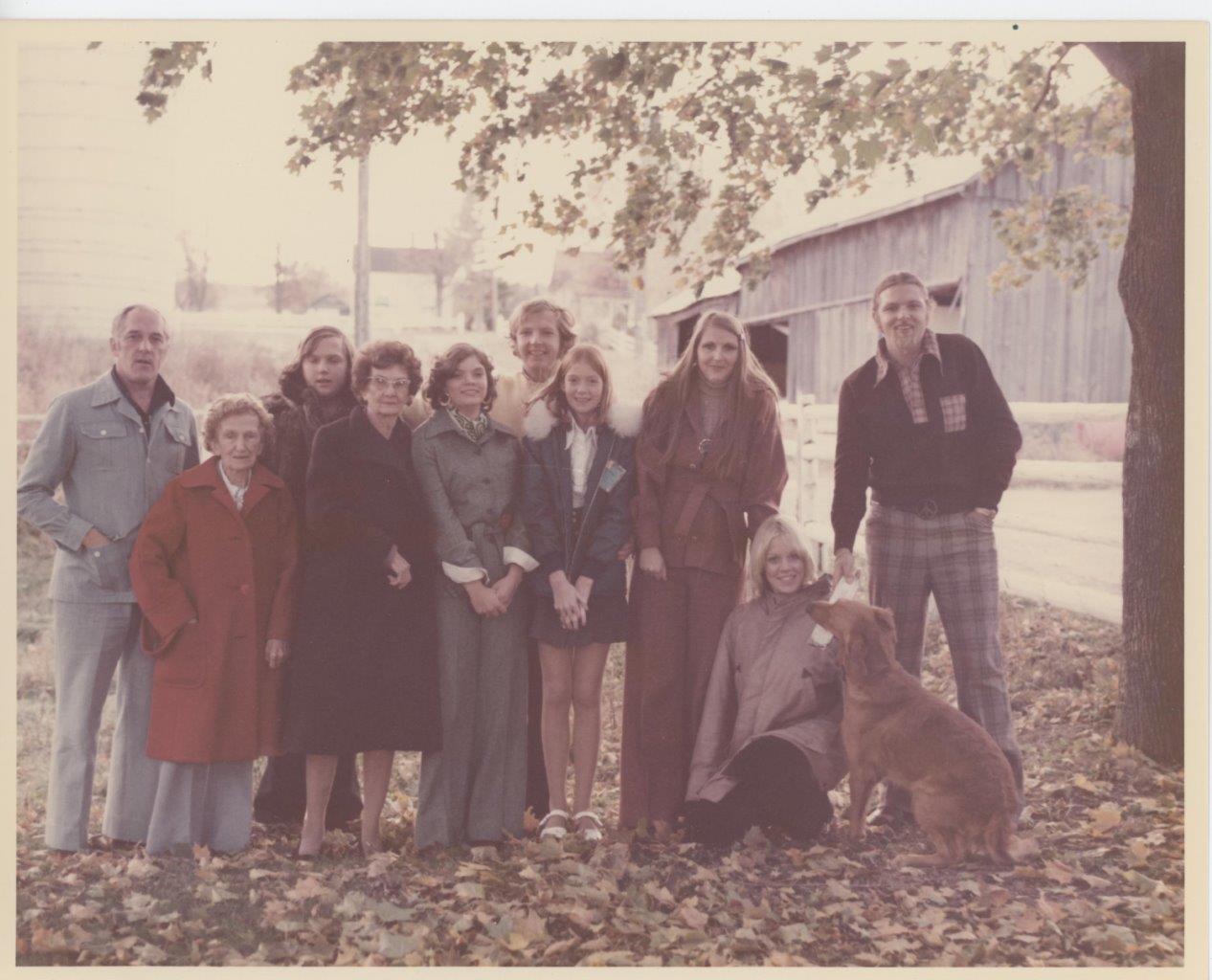 Annie Thompson my hockey mentor, in the red coat, second from left.
Annie Thompson my hockey mentor, in the red coat, second from left.
Her name was Annie Thompson, and she was my maternal grandmother’s best friend. These two ladies were a huge part of my life, in very different ways. My grandmother was a refined, cultured woman with a soft, loving soul. Here name was Anne as well.
Annie, who chose to be a spinster after here fiancee died suddenly of a heart attack, moved into my grandmother’s house permanently after my grandfather passed a year later.
This lady was the ultimate tom-woman. She could throw a football so hard I could barely hold on to it. She could run like the wind when we played tag, and we spent hours playing catch with our baseballs and gloves.
But the one thing Annie loved most was hockey, hockey, hockey, and I would learn the nuances of the game literally at her knee.
Miss Thompson worked in a managerial position at a label production company and liked to spend her winter nights at the Mutual Street arena with colleuges from work and friends cheering on the Toronto St. Patricks, Toronto’s first NHL franchise and Stanley Cup winner in 1922. This is where she learned all about hockey.
During the 1950’s Maple Leaf Gardens would host two Junior A hockey games starting at noon Sunday featuring their farm teams, the Toronto Marlboroughs and St. Michaels College Majors against two opponents from the Ontario Hockey League.
The history of these two home teams is fascinating.
The Marlboroughs were founded in 1903 by a group of sportsmen and named after England’s Duke of Marlborough.
St Michael’s College School was founded by Basilian Fathers from France in 1852. Their hockey program commenced in 1906.
Both of these teams played in the Ontario Hockey league, and they were bitter rivals from the beginning, primarily because of their religious backgrounds. Toronto was staunchly Church of England in it’s early years, and the Catholics were barely tolerated. The hockey rink was an opportune way for each side to show it’s dominance over the other, and many a battle royal turned the ice to crimson.
On those Sunday afternoons they would battle other foes, never playing each other, and what great hockey it was!
We had a Sunday routine on those special days, usually twice a month. We would drive into downtown Toronto, and check into a room at the Royal York Hotel. My grandmother would invite some of her friends to stop by for lunch and leisurely afternoon while Annie and I hopped on the city’s new subway system and sped north to the Carlton Street station.
A block away sat Maple Leaf Gardens.
Annie was very particular about where we sat, her choice of seats being on the rails, front row right up against the glass, a few seats to the side of the goal that the opposition net minder would tend for two periods. From here we had a clear view down the length and width of the ice, and we were so close to the play we could reach out and touch the participants if it weren’t for the glass.
As we sat side by side, she was constantly pointing out the sublties of the game, how a defence man took the body, not the puck, clearing the front of the net to give the goalies a clear view, forwards back checking to stop opposing rushes and especially the idiosyncrasies of the goalies that were right in front of us.
Now remember in the 50’s there were no helmets or goalie face masks, so we got to see these athletes up close and personal. And what players they were!
The teams in the O.H.L. were feeder teams to their NHL parent clubs, so the St. Catherines Tee Pees were tied to the Chicago Black Hawks. Seeing Bobby Hull with his blond hair flowing as he streaked in on a goalie was a sight etched in my memory forever. All stars Stan Mikita and Pierre Pilote were on that team as well.
The Guelph Mad Hatters, who would later become the Kitchener Rangers, were New York Rangers team had young Andy Bathgate and Rod Gilbert.
The Barrie Flyers were a Boston Bruins hook up and sported a firey player named Don Cherry, now Canada’s number one hockey commentator.
The Peterborough Petes, well nobody liked them because they were sponsored by the Montreal Canadiens, and had future hall of fame Scotty Bowman behind the bench.
One sad story is that the famed Oshawa Generals, founded in 1937 and the team the great Bobby Orr would play for in the early 1960’s, were disbanded during this time because of a fire in 1953 that destroyed their home rink. The team wasn’t reinstated until 1962 when their new rink was completed.
As for the hometown boys, so many of them became household names and Stanley Cup champions it is really quite incredible.
The Smythe’s forte was scouting the hinterlands of northern Ontario for raw material, i.e. exceptional undiscovered hockey players. The Marlborough roster that I watched play included future Leaf Captain GeorgeArmstrong, Bobby Baun, Carl Brewer, Ron Ellis, Brad Park and Bob Pulford.
The Irish boys from up the street in the double blue jerseys included Gerry Cheevers, Frank Mahovolich, Dick Duff, Red Kelly, Dave Keon, and the incredible defensemen Tim Horton.
Each and every one of these players earned one or more Stanley Cup rings, and having a chance to see them in their youth was something I will never forget.
One last thing about my hockey instructor Annie.
When I asked her who she liked better, the Marlies or St. Mike’s, there was no hesitation. Having been raised a proper Catholic girl, she had to side with the Irish. This did have one advantage because St. Mike’s coach in those days was Hall of Fame player King Clancy, who worshiped at the same cathedral. She would often wonder off over to the St. Mike’s bench before a period started and arrive back with a logo puck, and one time, even a stick after an Irish win.
It wasn’t until years later that I realized that this little Scots woman had taught me how to watch a hockey game, and even more importantly, how to watch hockey players.
Her lessons would serve me well down the road when I was running my own hockey operation.
From where we sat right at ice level close to the goal ,you could see everything that was important in the game happen in great detail.
Annie would tell me to watch how the offensive players carried the puck over the blue line. Did they have the sixth sense of knowing where their line mates were? Would they more often shoot a wrist shot or a slap shot or deke and pass? Were they a strong presence in front of the net, or tenacious in the corners to get the puck out? Did the back check and for check?
For the defensemen, would they play the man or the puck as the enemy entered their zone? Were they a physical force clearing the goal crease and did they keep the goalie’s sight lines clear? Did they have cannonading slap shot from the point and could theY win battles in the corners and clear the puck up and out of their zone?
The goalies were the most interesting to watch because they were always right in front of us for the entire period. With no masks on, we could see their facial expressions for every move they made. The joy of making a great save and the pain and embarrassment of letting in a squeaker or a losing goal in the last second. Would they come out of their crease and attack the play or stay back in their net? How acrobatic and flexible were they? Did the have a good glove hand? Did they use their sick and blocker glove effectively? Did they give direction to their teammates in the heat of battle or were they mute?
And speaking of battle, there were almost always fights. Many, many, many fights. The fans loved it, especially if our gladiators got the best of the heathens. Even better if their blood was spilled. Tag team bouts and free-for-alls were even more thrilling, and if the bout was in our end, we had ring-side seats.
I wonder now about the cerebral damage done to those young boys that gave their all for the team. So much has come to light about the after effects of multiple concussions and brain damage. It has lead to some tragic events.
That said, I will be forever thankful to my hockey mentor, Annie Thompson, bless her soul!
A Teammate I Will Never Forget
The St Andrew’s College Under 15 Team 1963
The photograph above is the only picture of me in a hockey uniform. It was taken in 1963 when I was in boarding at St. Andrew’s College in Aurora, Ontario.
I am in the top row, last player on the right.
Although I loved hockey, my playing career lasted only a few years in high school. Canadian football was my sport of choice. I ended up leaving St. Andrew’s to play football at my local high school, York Mills Collegiate. My first year there we went undefeated and won the city championship, so the move was well worth it. I continued to play football in university but my love of hockey never waned.
This was the school’s under fifteen team, so we were all fourteen years old and for most of us it was our first winter at St. Andrew’s.
Take a look at the young lad in the second row standing beside the teacher on the left side of the picture. His eyes are looking off to his left. (our right)
His name is Donald ‘Donny’ Robson, a Toronto boy who ended up being a lifelong friend.
Except that Donny’s life didn’t last nearly as long as it should have.
Donny was the always smiling, happy go lucky buddy in a large gang of guys that went through life together, sometimes not seeing each other for a few years but always reconnecting like it was yesterday.
His chosen career was in bond trading and after achieving all he could in Canada he moved with his wife Kathy and son Geoff to New York city in 1983. A second son Scott would be born the next year.
He loved his life in the U.S., but never forgot his Canadian roots and friends.
His career flourished to the point that he was a partner and senior vice president of his firm.
As fate would have it that firm was Cantor Fitzgerald, and Donny was at his 103rd. floor office in the north tower of the World Trade Centre on the morning of September eleventh, 2001.
He never made it home again.
His memorial service in Toronto was the most heartbreaking occasion many that attended had ever experienced. Donny was fifty-two years old.
In January 2016 my wife and I went to the World Trade Centre Memorial and Museum to pay tribute to Donny. t was one of the most emotional experiences we have ever encountered.
Because this is a hockey story and Donny was the only hockey teammate I ever stayed in touch with, I wanted to tell his story here.
All of the people that knew Donny wish that he was still with us.
The photograph below was taken at the museum.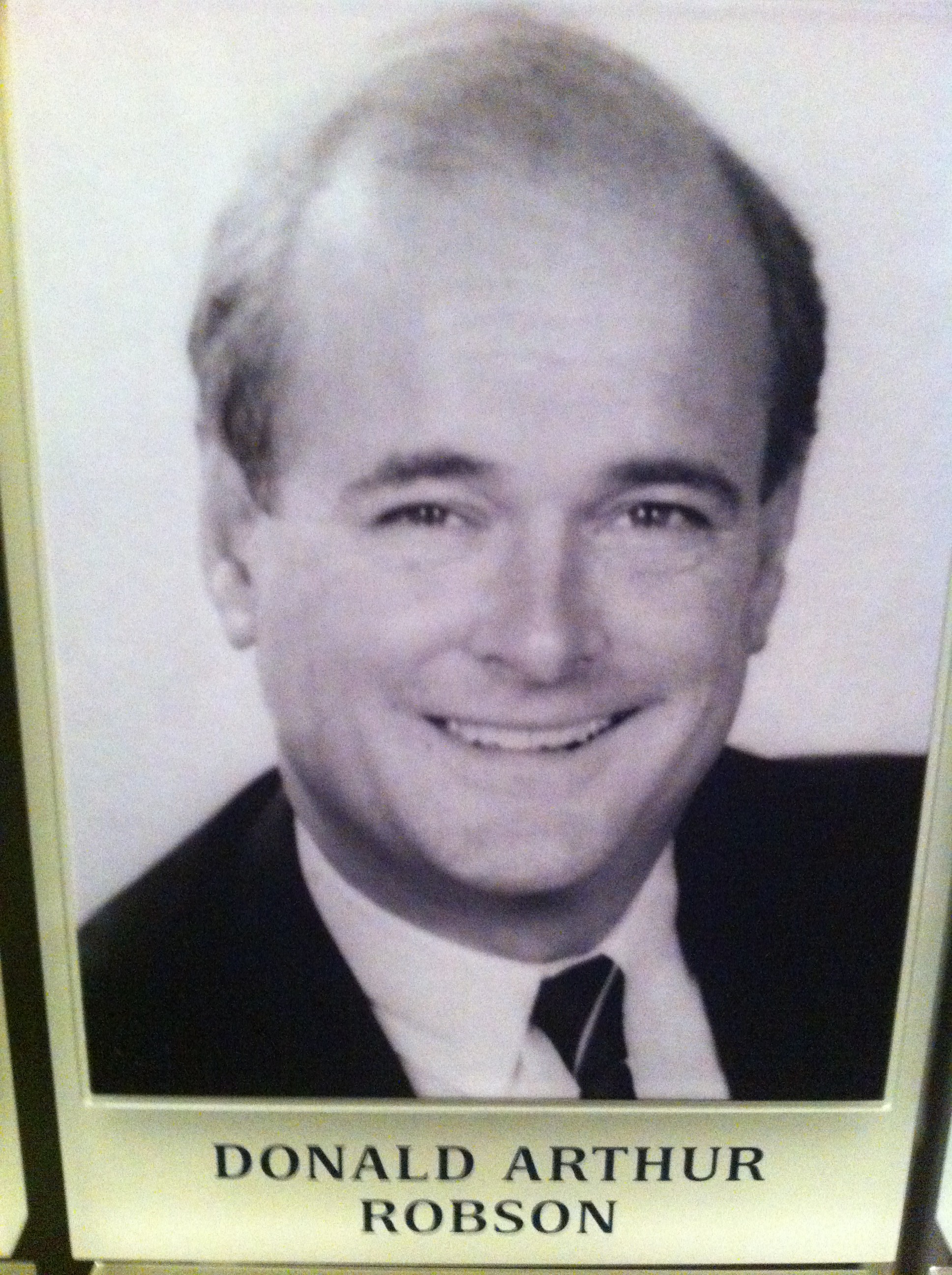
From Fan To Business Fan.
Double Breasted Days 1972
After university I became involved with the real estate industry, which I stayed active in for the next forty years.
There were, however, some side trips in my business career.
I began to get my hockey fix from the local Junior B hockey teams. These kids were the up and comers, usually under eighteen years of age. In the early 1970’s the Metro Junior B loop consisted of eleven teams spread throughout the city as well as nearby smaller towns.
What I loved about following these teams were the old style hockey rinks they played in. They were classic barns. The Dixie Arena in Mississauga was the home of the ‘Beehives,’ as in corn syrup. Weston Arena had the ‘Dodgers,’ Aurora, the ‘Tigers,’ Richmond Hill, the ‘Rams,’ and St. Michael’s College School, the ‘Buzzers,’ just to name a few.
A lot of games were played on mid week nights when there was nothing better to do and I enjoyed watching this wide-open free flowing brand of hockey. So did all the O.H.A. (Ontario Hockey League) Major Junior scouts.
Because I hung around the rinks so much I got to know several of the scouts, general managers and team owners.
One night in late 1970 I was a North Toronto Arena which was a swanky new facility located in the mid-town area of Toronto. An organization called the Toronto Young Nationals had made this their home rink and they sponsored a full complement of seven minor MTHL ( Metro Toronto Hockey League) teams and one Jr. B club. The kids ranged in age from ten to eighteen.
I got talking to the Jr.B general manger, who was a fellow by the name of Doug Michel. We hit it off right away, but little did I know that night that Doug Michel would become an intrical part of my future hockey endeavours.
It turned out that Doug Michel was more than just the Jr. B manager, he was the inspiration, founder and owner of the Young Nationals hockey franchise.
Doug grew up in Toronto a hockey nut, just like almost every other kid of his era. He dropped out of school after grade nine to apprentice in the electrical trade. He ended up owning his own company by the time we met.
His first venture into hockey management was when he coached his son’s hockey team. This is not an unusual occurrence in minor hockey, but nepotism never really ends well in sport.
Next, his company became a corporate sponsor for one hockey team, then two. While this was good for his ego, it wasn’t so good for his wallet.
Doug was always looking for a better angle to make things profitable. In 1968 he came came up with a doozie.
While the National Hockey League had always been the premier venue for Canadian hockey talent, the international hockey competitions were different kettle of fish.
N.H.L. players were considered professionals by the International Ice Hockey Federation located in Switzerland. Their president, an Irishman named Bunny Ahearne, hated Canadians and their superiority complex, so he made sure only our unpaid amateur players could compete in the Olympics and World Hockey championships.
The Russian hockey bear had awakening in Europe, and our teams were continually thrashed during the 1960’s.
Disgusted with these events Doug set out to change them. Father Davis Bauer, a Catholic priest based out of Toronto’s St. Michael’s College was in charge of Canada’s amateur hockey program. He was as upset as Doug about the international situation.
Michel’s suggestion was to set up an elite feeder operation for the best and brightest young players to play together, first in Toronto, and then right across Canada with the primary goal of supplying the finest talent to our national team.
Father Bauer and the Canadian Amateur Hockey Association bought into the idea, and the Young Nationals were born.
Doug formed a roster of eight MTHL teams in Toronto, and while his dream of feeding our national team never materialized because professionals were eventually allowed to compete in international competition, the Young Nationals are still one of the finest hockey organizations in the country.
Such was the vision of Doug Michel.
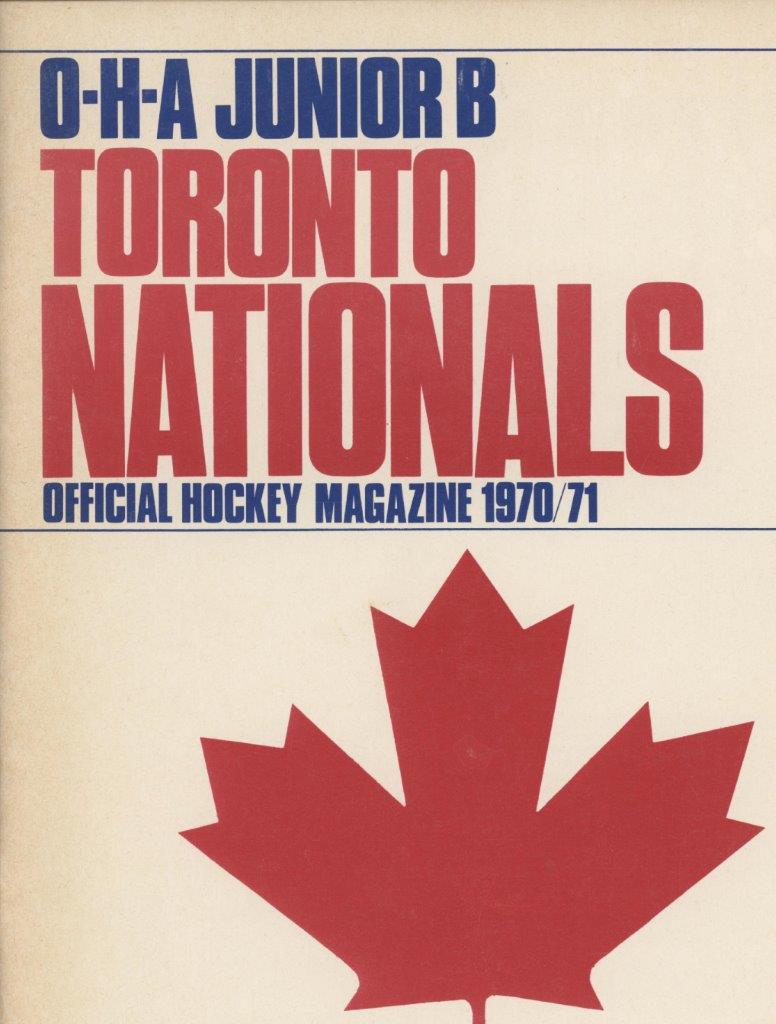
But back to 1970 now.
The Nat’s Jr. B was new to the Metro league that year. Doug had joined forces with a group headed by a gent named John Gardiner who ran the Toronto City North Stars Jr. B team to form the Young Nationals entry.
After my initial chat with Doug I kept running into him a Nat’s games. One night we went for a drink after the game. He informed me that he and John Gardiner were fifty-fifty owners of the Jr. B team and they were interested in taking in some investors.
Then he asked me if I would be interested.
I wanted to know right off the bat what the downside was. I enjoyed hockey as a fan, but being an owner and paying the bills was something else.
Doug prepared a pro forma of all the team’s expenses and revenue and asked for a fee of $5,000. for one third of the team’s shares.
The projected deficit for the following year was just under twelve thousand dollars, but under Canadian tax laws at the time, the entire deficit could be written off against an investor’s personal taxes.
Sounds crazy doesn’t it, but it was the law at that time.
I had made a few real estate deals and had a little cash, so if figured if I was going to hang out at the rinks, why not to it as an owner.
On March 10th 1970, I became a one third owner of the Toronto National Jr. B hockey club.
I was three months away from my twenty-second birthday.
So it was back to school time, hockey school. Not at a rink, but at a desk.
Budgets, expenses versus revenue, fund raising, personnel, as much as I loved hockey I had no idea of the financial costs involved in operating a team, and this initial eye opener served me we’ll down the road.
For the Nat’s 1971-72 season, the projected costs were as follows.
Equipment: $ 5,000.00
The team bought all its equipment rom one retailer, Jack Watson Sporting Goods and received a big discount.
Arena Ice rentals: $ 4,715.50
This figure is based on 22 home games at North Toronto Arena for $35./hr. plus two, two and one half hour practices per week as well as tryouts and pre season games.
The hourly price of ice at North Toronto Arena in 2015 was $ 195./hr.
Salaries and Gratuities: $3,150.00
We paid an accountant to keep the financial records of the team and $550. to the team trainer.
Player Payment: $ 2,376.00
We were required to remunerate or players for travel and food costs $3.oo per game.
18 players x 44 games equals the amount above.
Referee’s Fees: $ 1000.00
We were responsible for paying the refs for all home games.
Printing: $ 2,500.00
Our annual team program plus fund raising event flyers and newsletters.
Purchase of Players $ 1,050.00
Teams were able to trade player for a fee set by the league. This usually occurred before the season started or just before the playoffs.
There were also expenses for League fees, insurance, advertising, cleaning and miscellaneous items totalling: $ 2,300.00
The grand total expense was estimated at just over $ 25,000.
Now the hard part, trying to estimate revenue.
A stand alone team such as our Jr. B’s had a much harder time raising funds than a full organization with a large group of parents, coaches and volunteers.
First of all the younger kids were responsible for their own equipment, other than gloves, helmets and uniform. If a family was of modest means, there would be help with buying skates.
The Nat’s minor system made each team raise money for tournaments and to help the overall costs. The boys had to knock on doors selling merchandise to pay their way. Often the parents would just write a cheque.
We would make about $ 2,000. on a Monte Carlo gala night, then it was up to program advertising and sales, 50/50 cash draws at games and gate and concession receipts.
Our budget planned for $ 13,000. in revenue, giving us a projected $ 12,000. deficit for the season.
You gotta love hockey to get into this racket!
The other education I received was in player management and motivation, and there was no better teacher than Doug Michel.
Although small in stature, Doug had the heart of a lion, and the temperament to match. When things weren’t going well during a game, even though he was the general manager, he would storm into a dressing room and make his comments perfectly clear. His favourite motivational tools were a broken hockey stick and a metal garbage can.
He would single out an offending player and bang the drum, not so slowly. His message always got through loud and clear. No coach ever told him not to intrude.
That said, Doug was a congenial, thoughtful man with an insightful hockey mind. He could charm parents of prospective players with ease and grace, and for the same reason the best coaches lined up to join his organization. He was tough, but always fair, and the Young National were one of the premier organizations in Canada because of Doug Michel.
I’m thankful that at least some of his knowledge rubbed of on me.
My other partner, John Gardiner, was an experienced, knowledgeable hockey man as well, but it turned out that bigger plans would come his way.
Early in 1972 John had an opportunity to work in the airline business, and because of travel commitments, decided to sell his Nats shares to Doug and me.
John did keep active in hockey as a volunteer director of the Metropolitan Toronto Hockey League, the body that oversaw all facets of organized hockey in Toronto.
In 1980 he was elected president of the organization, and his term lasted an amazing thirty-five years. The MTHL is billed as the largest minor hockey organization in the world with 40,000 participants, and John was such an efficient administrator that in 2006 Hockey Canada honoured him with it’s Order of Merit.
On the ice, where it all counts, we had a fairly strong team. Part of our strength was that many of our players had come up through the Young Nats minor teams and knew each other. Eight of our player came up from our championship midget team, another five from the older juvenile squad.
The thing about watching young hockey players is that the cream usually rises to the top quickly. A good eye can spot a player with a hockey future, and in our case all eyes were on our captain, Rick Middleton.
Rick played the previous year on our midget team and had already been a high draft choice of the Oshawa Generals, but at sixteen he wanted to stay at home one more year. Lucky us.
He was a fleet-forted winger with soft hands around the net, and lead the league in scoring that year.
Rick had a stellar career in Oshawa leading the league in scoring in his final year.
Drafted fourteenth by the New York Rangers in the first round of the 1973 N.H.L. draft, Rick was traded to Boston Bruins in 1975 where he flourished. In 1985 he scored fifty-one goals and won the Lady Byng Trophy for excellence and sportsmanship. He also represented Canada in the 1981 and 1984 Canada Cups. And it all started with the Young Nats.
Unfortunately for on Jr. B team Rick didn’t have enough quality support, so we closed our the 1970-71 season in fourth place.
There is no down-time in hockey, so rebuilding for the next season starts as soon as the dressing room is cleared on the night of last game of the current season.
Little did Doug and I know that there would be a considerable distraction occur during our 1971-1972 season.
The World Comes Our Way.
In the bigger picture, the events that were about to take place in 1972 would shake the very foundation of professional hockey and change the game throughout the hockey world.
And I had a small part in making it happen.
It all started with a phone call in January 1971 from a California sports promoter, Dennis Murphy to his lawyer / associate Gary Davidson.

The WHA big three, Gary Davidson, top, Don Regan left, Dennis Murphy, right.
As Davidson describes the conversation in his autobiography ‘Breaking The Game Wide Open,’ Murphy asks him, ” What do you think of starting a new major hockey league?”
From just about everyone else this question would have sounded completely ridiculous. But not from Dennis Murphy. In the mid 1960’s Murphy had tried to acquire an NFL franchise for Anaheim stadium outside of Los Angeles. When the NFL merged with the renegade AFL, his plans fell apart.
Gary Davidson was the man for this job. He and Murphy had worked together in the rebel American basketball Association from in the late 1960’s. Davidson was a gambler. His blond California surfer-boy looks belied a street smart toughness of a man who had to fight for everything he got out of life. He loved a good brawl, and the N.H.L. would be his next opponent.
By September 1971, the new formed World Hockey Association had fourteen prospective franchisees at their first formal meeting in Los Angeles. Three cities from Canada were represented, Edmonton, Calgary and Winnipeg.
At this point no formal announcement had been made about the leagues existence. The new president, Gary Davidson, decided it was time to change that. leaked rumours spread like wildfire through there hockey circles around North America.
That same news made it into the Young Nationals office in North Toronto Arena.
Doug Michel and I were always trying to find new sources of revenue to held defray the costs of running a hockey organization. When word of an upstart new league reached us, we were very curious about which cities were involve. Were any cities from Canada, and if so was Toronto in the mix?
We manage to get Gary Davidson’s phone number from the Toronto Star newspaper sports reporter Milt Dunnell. We promised Milt a ‘scoop’ if anything became real because of his help.
We managed to get through to the man himself. Davidson was very hesitant to give out too much information over the phone. He stated that the franchise fee was $ 1 million dollars, but said that he knew what a great hockey town Toronto was and if we sent him some information about who we were and what we had accomplished, he would get back to us if he liked what he saw.
We did and he did.
Right off the bat he told us the franchise fee was only $25,000. There was more money needed down the road, but it hadn’t been determined how much yet. We were informed that there was going to be a meeting in New York city in two days time where a formal announcement would be made that the W.H.A. was going to be in business with ten solid franchises.
We were also informed that we were welcome to attend the meeting.
We did.
We considered two main problems on our way to the fair. Were there going to be other big hitters from Toronto with the same idea, because Davidson had been non committal when we asked him that question, and most importantly, where would we play our games?
Maple Leaf Gardens, home of the N.H.L. Maple Leafs was the only poor sized arena in eastern Canada. We didn’t think they would be a very friendly landlord, us being the upstart rebels.
We settled on looking into a town about fifty miles west of Toronto on Lake Ontario, Hamilton.
It was a great sports town with their Canadian Football League team the Tiger-Cats having a storied long time rivalry with the Toronto Argonauts. Hamilton was also close to Buffalo, which would bring their fans over the border for away games.
But first things first. A meeting at the Americana Hotel, New York, New York. It was October 30, 1971.
I ‘ll never forget walking into that boardroom, wood panelling and cigar smoke. Right away we looked for was we recognized from Toronto. It was the first w=question we asked Gary when we were introduced. He smiled and said we were the only ones from eastern Canada.
Whew!
We had brought along Bill Page, a good friend of Doug’s who was in the advertising and marketing business. Bill was a good pitch man and he made our initial pitch then Doug and I had few things to say. We talked about Ontario’s hockey heritage and our own history in the sport. They asked us, “how much money can you stand to lose the first year?” to which Doug brazenly answered ” one million dollars but we don’t plan to lose anything!”
It turned out that there were fourteen prospective franchisees in the room, and they wanted to announce a firm ten the following morning at their press conference. Listening to a few of these men talk, I had some strong misgivings about the company I was thinking of keeping.
‘Shady’ would not be too strong a description.
The arena question was raised by the group and we had managed to pull a rabbit out of our hats for that one.
The mayor of Hamilton was a gent by the name of Vic Copps. mayor Copps loved Hamilton and he also loved sports. Somehow Doug got through to him on the phone the day before we left for NYC, and Vic bought into our whole plan. Without even laying eyes on us he sent said he would courier aerial photos of prospective area sites to out hotel along with a info on Hamilton and a good luck telegram. Good old Vic came through, big time.
” Doug Michel and Jim McCreath: wishing you success in your bid to bring World Hockey Association franchise to Hamilton. City negotiating with several groups for new arena to present world hockey action in the world’s newest facilities. Hamilton pro football biggest money maker in Canada. Hamilton hockey can be too so keep on shooting till you hit that goal for Hamilton. Victor K. Copps, Mayor.”
Both parties were hesitant about making a deal that day, so it was decided the ten original cities would be announced the next day and the other four would be given ‘conditional’ franchises to be settled on at the next governor’s meeting in Miami the third week in November.
That was fine with us, but now we were about to be named in a press conference the next morning as ‘conditional franchise’ holders in the W.H.A. Bill Page said we should be proactive and have our own press conference in Toronto after we flew in that night.
We checked into a suite at the old Constellation hotel by the airport and Bill got on the phone. It was a Sunday night, we expected nobody to show up at a 10:00pm press conference.
Boy, were we wrong. At least twenty reporters and three television stations packed the room and asked us questions for over an hour.
The league had told all the franchisees to stick to the script that the franchise fee was $1 million., so that’s what we did.
It was one of the craziest experiences of my life, but not as crazy as telling my dad on the phone what he was going to read and hear about me the next morning in the media.
To his credit, he was quite calm and enthusiastic about the whole thing. We had talked about the possibility of seeking out investors for second N.H.L. team in this hockey mad town, and he told me that he could be helpful in setting me up with potential partners, if and when I figured the investment had merit.
The next month was a whirlwind of meetings, press conferences, several trips to Hamilton and trip Barbados to track down a land owner who had our preferred arena site as one of his holdings. The league sent people up to check us out and we gave them the royal treatment. We even dropped a W.H.A. puck at one of our Jr. B. games.
The league has also sent up financial projections, franchise documents and prospective roster list of existing N.H.L. players for us to study.
While I was enthusiastic about vetting this new and fabulously exiting new adventure, I couldn’t get the image of some of the ‘shady characters’ I had met in New York out of my mind.
We arrived in Miami for our meeting with a lawyer and accountant who had worked the numbers and the contracts. They were both extremely skeptical that this dog could hunt.
When we had our turn to present to the governors, we were met with the same cigar smoke, but many of the men were attired in flamboyant Hawaiian shirts. We were in suits.
Davidson opened the meeting by saying that they were impressed with our sincerity and ability but there was a slight change in the terms, the fee was now $200,000.
It was explained that we were ‘newcomers,’ and as such didn’t rate the initial franchise fee.
How quickly can you say ‘adios?’
Back in our hotel room Doug was still keen to proceed. He didn’t have the means to carry on alone, but he was blinded by his passion. He pleaded with me not to make my decision public for thirty days so he would have a chance to find new investors. I really cared for Doug, but I could see that the pressure was taking a toll on his health. Even so, it was the least I could do for him so I agreed to keep quiet for the thirty days.
The press covered my short announcement that I no longer participating in the Ontario franchise of the World Hockey Association and I went back to looking after the Young Nationals. Doug had sold his share to me for a reasonable price.
For Doug Michel, the road would only get rougher. The Hamilton deal fell through, but he managed to find a home in Ottawa, the nation’s capital. His team, known as ‘The Nationals,’ would play their home games at the 10,000 seat Civic Centre. They would share the rink with the very popular Jr. a team, the 67’s. Many Ottawa citizens considered the Nationals as unwanted usurpers in their beloved 67’s market.
Bill Page had quit his job and moved to Ottawa to help Doug. Money was always a problem, but Doug was able to bring in a well healed investor from Buffalo, Nick Trbovich.
The team had to put 7,400 bums in the seats to break even every home game and the rarely came close to that number. Opening night with lots of fanfare and an $80,00 advertising campaign, they drew 2,054 paying fans.
The team bled dollars. The city fathers were worried about getting paid their rent for the rink and became antagonistic toward Doug and the team. They wouldn’t guarantee a second year’s lease without a $100,00. bond being posted. Both Doug and Nick refused.
The team made the playoffs, but with the threat of being locked out of their home rink, Doug moved the team’s equipment in the dead of night to Toronto. He had made a deal with Maple Leaf Gardens to play all their playoff games there.
That was the end of the Nationals in Ottawa. Doug Michel would forever be a persona non grata in that town.
Things didn’t go much better in Toronto. They drew under 5,000 quiet fans for their first home playoff game and 4,000 for their second and final game.
Nick Trbovich took over complete control of the team and within weeks sold it to Johnny F. Bassett for $1.8 million. Doug, who owned 15% of the team never received a cent for his share.
So this was the sad end to a great hockey man’s dream. All Doug got for his blood sweat and tears was an ulcer, that eventually ended his journey.
He was a great hockey mentor for me, as was Annie Thompson. May they both rest in peace.
World Hockey Press Clippings
A New Tail, Just About The Last.
Glad put the WHA behind me I turned my attention to the Young Nats. With Doug gone it was time to reassess our personnel and make some changes.
One exciting occurrence was that our Jr. B team was being elevated to what the Ontario Hockey Associated designated as a Tier II Junior A league. The OHL Jr. B loop would still exist, but all the existing teams would have the opportunity to move up a notch when the season started in October 1972.
This meant that we would be direct feeder teams for the Major Jr. A teams in Ontario, and have access to their cast off players. The calibre of hockey would increase dramatically, and so, we hoped would attendance.
The League added two new teams, Kingston and North Bay, both about two ours drive from Toronto. So the teams we would be competing against were from Richmond Hill, Ajax, Senaca, Dixie, Wexford, North York, Weston, Downsview and Aurora. Some of these teams were from communities outside of the city, other were from neighbourhoods within it.
Our main problem was finding a home rink, because there was no ice time for our new team at North Toronto Arena.
Needing a home I turned to long time Nations supporter, administrator and manager Paul Winnell. Paul had worked with Doug Michel in a number of capacities and was one of the most all round knowledgeable hockey people I have ever met. He was a supreme fan too, and bled red and white for our boys.
Paul found us a home in a small bedroom community just north of the city limits, Maple Ontario. Because we of the towns small size we named the team after the larger region, which was Vaughan.
So in the fall of 1972 The Vaughn Nationals were born, the team that wayne Gretzky would leave his hometown of Brampton to play for two years later.
The mayor of Vaughn, Garnett Williams was thrilled to have big time hockey come to his community and he bent over backwards to get theatre money for improvements in the new rink.
More seating was added, our dressing room was enlarged and enhanced, a press box was installed hanging from the rafters and a general feeling of enthusiasm prevailed in every facet of this new enterprise.
Now we needed a team to fill the rink.
Our Jr. B team had an excellent core of players, and even some of our midgets were good enough to make the leap to Jr. A. But to be top notch we needed help, and we got that help from the Toronto Marlboros Major Jr A club.
I had know of Tom Smythe, grandson of Conn Smythe and son of Stafford Smythe for some time. This family built had built Maple Leaf Gardens and the Toronto Maple Leafs into an iconic sports franchise.
Tom, who was two years my senior and a chip off the old family block as far as hockey smarts, was the general manager of the Marlboros.
Our hockey relationship turned into a friendship that lasted over thirty years.
We were able to pick up three excellent cuts from the Marlies, sniper John Cook, rugged forward Ron Bobbette, and a hard nosed defenceman, John Cowan.
We also traded with the Aurora Tiger to get six foot seven inch Mike Hammond, one of the toughest hockey player I have ever laid eyes on.
We had speed, fitness and toughness, and we ended up finishing in first place during the regular season.
I must admit that my WHA experience had taken it’s toll on my hockey mindset, which resulted in my paying a lot more attention to the Jr.A team than any other part of the organization.
Thank goodness for Paul Winnell, who put together a terrific blend of coaches and managers that were able to put many of the city’s best players in a Nats jersey.
Our Jr.A coach was the best hire of all.
George Storey had coached the Barrie Flyers to a Canadian championship in 1953, and was a fine athlete in his own right.
A bombastic showman, was the best way to describe George behind the bench, but he was a superb teacher of the game, and many of his players went on to the NHL.
George’s brother, Roy ‘Red’ Storey was an acclaimed N.H.L. referee for many years.
I didn’t know it when the season started, but this would be my last few months in organized hockey.
But boy, was it exciting.
I want to share with you a few stories my final season, especially with those Jr. A lads.
But first, what did we look for in putting together this team.
Having been in many dressing rooms as a player, coach, manger and executive I’ve come to the realization of what elements are needed to make a championship team.
First you start with the natural talent of the individual players, then add the best coaching they can possibly obtain. Throw in top level competition, and very importantly, hope their off ice life is conducive to becoming a winner.
Then the process becomes like a jig saw puzzle. How do you fit the pieces together?
Each position haste’s own specific needs and skill sets. Find the right mix, and you have a good chance icing a decent team.
Alas, there are intangibles involved, especially something called team chemistry. Are they a ‘Band of Brothers?’ Will they drop their gloves for one another? Will they pal around outside the rink.
Are their cliques? Do the veterans mentor the rookies or treat them as second class?
On the ice, does the puck bounce for you in the tightest of games. How do injuries effect the lineup?
And above all, and this has to do with any sport that has a goaltender, is he or she the better than their opposite part on the big day?
Can the game saving stop be made.?
If it can, your team will be the champions. Second place awaits the team whose keeper can’t bar the door at that most critical of moments.
Championship start from the net out.

The 1972-73 Vaughan Nationals
Front row, Ray Hough, John Winder, Earl Methe, (mgr.) Ron Harris, George Storey,(coach), Ron Bobbett, Bob Volpe.
Second row ,Gary Gill, Bobby Osborne, Doug Bernett, Charlie Hughes, Ray Koopman, Ron Harris, John Cook.
Third Row, Glen Barnett, Paul Clarke, Mike Hammond, Max Carter, Al Love.
Absent, John Cowan.The Last Chapter.
No More Cheese.
I had lots of fun with our Jr. A team. It was one of the most cohesive groups I had ever come across, but it was time to move on.
The team was sold, as mentioned in the opening chapters and I went on to explore the music industry.
But some crazy things happened that kept me involved with the hockey world nevertheless.
I ended up knowing and doing business with the Toronto Big Three families, The Bassetts, The Ballards and the Smythes, but that’s a whole other tail to be told in another post.
Remember, as Conn Smythe said,
“If you can’t beat ’em in the alley, you can’t beat ’em on the ice!”

